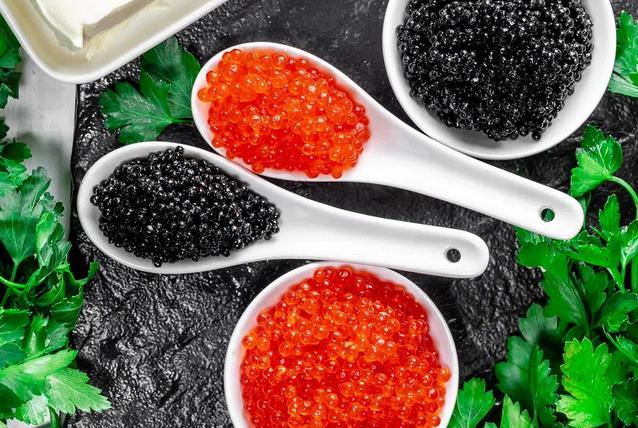Black caviar and red caviar are two of the most sought-after delicacies in the world of gourmet seafood. Each has a unique flavor profile, texture, and origin, making them distinct in both culinary and cultural traditions. Many connoisseurs and first-time buyers often ask: What sets them apart, and which one is the superior choice? If you’re looking for premium caviar in Atlanta, explore our selection here https://bestercaviarstore.com/pages/atlanta.
Origin: Where Do They Come From?
The fundamental difference between black and red caviar lies in their source. Black caviar is derived exclusively from sturgeon species, including the renowned Beluga, Osetra, and Sevruga. These ancient fish have been harvested for their luxurious roe for centuries, primarily from the Caspian and Black Seas. Due to the long maturation period of sturgeons, black caviar remains a rare and highly prized delicacy.
Red caviar, on the other hand, comes from various species of salmon, such as Chinook, Sockeye, and Coho. Unlike sturgeons, salmon reach maturity much faster, making their roe more abundant and widely available. The harvesting process for salmon roe is typically less complex than that of sturgeon caviar, contributing to its more accessible pricing and higher availability in markets worldwide.
Taste and Texture Differences
Black caviar is celebrated for its smooth, buttery texture and complex flavor profile. Depending on the sturgeon species, its taste can range from mild and nutty to rich and briny, with a delicate pop that melts in the mouth. The aging and salting process—commonly known as “malossol”—enhances its natural flavors without overpowering them.
Red caviar offers a more pronounced, oceanic taste with a firmer texture. The individual eggs are typically larger and have a slightly stronger saltiness. Sockeye roe, for example, is known for its deep red color and bold, briny flavor, while Coho roe is milder and creamier. The curing process also affects the final taste, with some variations having a smokier or saltier edge than others.
Nutritional Value: Which One Is Healthier?
Both black and red caviar are nutritional powerhouses, rich in essential vitamins and minerals. They are excellent sources of omega-3 fatty acids, which support heart health, brain function, and overall well-being. However, there are key differences in their nutritional profiles:
- Black caviar contains higher levels of healthy fats, collagen, and essential amino acids, making it a premium choice for those seeking skin and joint health benefits.
- Red caviar is notably rich in vitamin D and antioxidants, which support immune function and cellular health. It also tends to have a slightly lower fat content compared to black caviar, making it a leaner option for some diets.
Price and Exclusivity
One of the most significant distinctions between black and red caviar is their price and availability. Black caviar is considerably more expensive due to the rarity of sturgeon, strict regulations on harvesting, and the lengthy maturation process. Some of the rarest varieties, such as Beluga caviar, can cost thousands of dollars per kilogram.
Red caviar, being more abundant, is significantly more affordable. While still considered a luxury product, its lower production costs and wider availability make it a more budget-friendly option for those who want to enjoy the indulgence of caviar without the hefty price tag.
Sustainability also plays a crucial role in pricing. Due to overfishing and conservation efforts, sturgeon caviar production is highly regulated, whereas salmon roe is more easily farmed and harvested, keeping costs more stable.
How They Are Served
Both types of caviar have their own unique serving traditions.
- Black caviar is traditionally enjoyed in its purest form—served on a mother-of-pearl spoon to preserve its delicate flavor. It pairs exceptionally well with blinis, crème fraîche, and lightly buttered toast points. For drinks, it is best complemented by chilled vodka, dry champagne, or premium white wines.
- Red caviar is often found in sushi, atop buttered toast, or as a garnish on canapés. It pairs well with a variety of beverages, including light-bodied white wines, crisp sparkling wines, and even sake.
Which One Is Better? (Final Verdict)
The choice between black and red caviar ultimately depends on individual preferences, budget, and the occasion.
- If you are seeking an exquisite, refined experience with a smooth, melt-in-your-mouth texture, black caviar is the ultimate choice. Its exclusivity and delicate flavor profile make it ideal for fine dining and special occasions.
- If you prefer a bold, slightly brinier taste and a more accessible price point, red caviar is a fantastic option. It is versatile, delicious, and perfect for everyday indulgence or casual gatherings.
Conclusion
Both black and red caviar offer a unique culinary experience, each with its own distinct qualities. Whether you lean toward the delicate elegance of black caviar or the vibrant, robust flavor of red caviar, the best way to decide is to try them both. Discover the finest selection of caviar in Atlanta and experience the taste of true luxury.







Leave a Reply